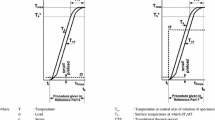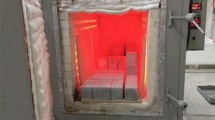Abstract
The effects of strain rate ranging from 10−4 to 300 s−1 on normal weight concrete after exposure to elevated temperature up to 1000 °C were experimentally investigated using a servo-hydraulic testing machine and a split Hopkinson pressure bar. The casted cylinder concrete specimens were firstly heated in a microwave oven, and then cooled down to the ambient temperature with control. Experimental results proved that the normal weight concrete after high temperature exposure still showed significant strain rate dependency. The dynamic increase factor(DIF) for compressive strength decreased with the exposed elevated temperature from 600 to 800 °C, and increased from 800 to 1000 °C. The DIF of concrete after exposure to elevated temperature is smaller than that at the ambient temperature according to CEB code. The larger the compressive strength is, the smaller the DIF of normal weight concrete after high temperature exposure will be. In addition, further comparison showed that the DIF after high temperature exposure is larger than that exactly at the same high temperature. An empirical model of DIF for normal weight concrete after elevated temperature exposure was proposed based on the experimental data. It obviously benefits the assessment of blast resistant capacity of post-fired concrete structures, as well as referred retrofitting techniques.









Similar content being viewed by others
References
Behnood A, Ghandehari M (2009) Comparison of compressive and splitting tensile strength of high-strength concrete with and without polypropylene fibers heated to high temperatures. Fire Saf J 44:1015–1022
Chang YF, Chen YH, Sheu MS, Yao GC (2006) Residual stress–strain relationship for concrete after exposure to high temperatures. Cem Concr Res 36:1999–2005
Chan YN, Peng GF, Anson M (1999) Residual strength and pore structure of high–strength concrete and normal strength concrete after exposure to high temperatures. Cem Concr Compos 21:23–27
Ding Y, Azevedo C, Aguiar JB, Jalali S (2012) Study on residual behaviour and flexural toughness of fibre cocktail reinforced self compacting high performance concrete after exposure to high temperature. Constr Build Mater 26:21–31
Luzio GD, Biolzi L (2013) Assessing the residual fracture properties of thermally damaged high strength concrete. Mech Mater 64:27–43
Kolsky H (1949) An investigation of the mechanical properties of materials at very high rates of loading. Proc Phys Soc Sect B 62(11):676–700
Grote DL, Park SW, Zhou M (2001) Dynamic behavior of concrete at high strain rates and pressures: I. experimental characterization. Int J Impact Eng 25(9):869–886
Li QM, Meng H (2003) About the dynamic strength enhancement of concrete–like materials in a split Hopkinson pressure bar test. Int J Solids Struct 40(2):343–360
Thomas T (1993) CEB-FIP model code 1990: design code. Comité Euro-International du Béton, London
Li QM, Lu YB, Meng H (2009) Further investigation on the dynamic compressive strength enhancement of concrete–like materials based on split Hopkinson pressure bar tests part II numerical simulations. Int J Impact Eng 36:1335–1345
Zhang M, Wu HJ, Li QM, Huang FL (2009) Further investigation on the dynamic compressive strength enhancement of concrete-like materials based on split Hopkinson pressure bar tests part i: experiments. Int J Impact Eng 36:1327–1334
Huo JS, He YM, Xiao LP, Chen BS (2013) Experimental study on dynamic behaviours of concrete after exposure to high temperatures up to 700 °C. Mater Struct 46:255–265
Liu CX, Li YL, Wu ZY, Guo WG, Ge YZ (2011) Dynamic compression behavior of heated concrete. China Civ Eng 44(4):78–83 (in Chinese)
Li ZW, Xu JY, Bai EL (2012) Static and dynamic mechanical properties of concrete after high temperature exposure. Mater Sci Eng A 544:27–32
Chen L, Fang Q, Jiang X, Ruan Z, Hong J (2015) Combined effects of high temperature and high strain rate on normal weight concrete [J]. Int J Impact Eng 86:40–56
Li W, Guo ZH (1993) Experimental investigation of strength and deformation of concrete at elevated temperature. J Build Struct 14(1):8–16
Deng Z, Xie R, Yan Y, Li SZ, Huang XC (2008) Temperature in high temperature SHPB experiments. Transact Tianjin Univ 14:536–539
Zhai Y, Deng Z, Li N, Xu R (2014) Study on compressive mechanical capabilities of concrete after high temperature exposure and thermo-damage constitutive model. Constr Build Mater 68:777–782
Acknowledgments
The authors acknowledge the financial supports from the National Basic Research Program of China (No.2015CB058003) and National Natural Science Foundation of China (No. 51378016, No. 51238007, No.51210012, No.51321064). The experiments were conducted with selfless help from Zheng Ruan.
Author information
Authors and Affiliations
Corresponding authors
Rights and permissions
About this article
Cite this article
Zhai, C., Chen, L., Fang, Q. et al. Experimental study of strain rate effects on normal weight concrete after exposure to elevated temperature. Mater Struct 50, 40 (2017). https://doi.org/10.1617/s11527-016-0879-4
Received:
Accepted:
Published:
DOI: https://doi.org/10.1617/s11527-016-0879-4




